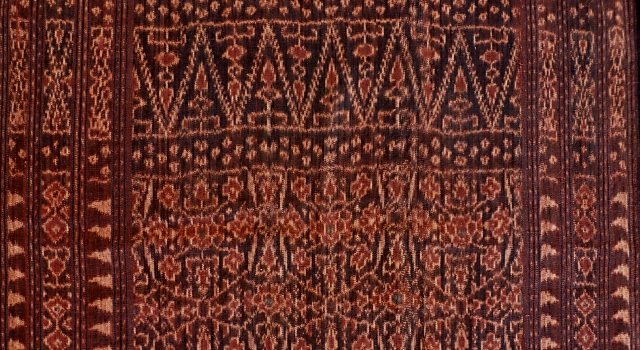Lio ikat - among the most sophisticated Indonesian textilesPatola inspired cloths for those of high rankThe Lio weaving region of Flores, a rough and wildly beautiful region between the Kelimutu volcano and the rocky coast, produces ikat textiles of outstanding technical quality and great artistic refinement that are extremely labour-intensive. Most, certainly the most highly rated, are unabashed patola imitations. There is no reason for the Lio people to be abashed, because patola have been imitated throughout the archipelago, and theirs are unparalleled in terms of complexity and delicacy. The patterns are usually executed in écru, light yellow (akar kayu kuning), or a pinkish light brown (pale morinda) on a reddish brown background (dark morinda, or morinda overdyed with indigo). Due to the rarity of the raw materials, taboos on working during certain periods, and the need for repeated steeping to achieve the desired colour intensity, the dyeing process of a traditional Lio cloth might take as much as eight years.The emblematic motif of the Lio region is the eight-rayed flower, jilamprang, the most prevalent motif on the silk double ikat cloths that the Dutch East Indies Company (VOC) imported from India to buy the loyalty of local rulers - only a few of whom were accorded the extraordinary honour of receiving such a costly gift. Imitations began to be made already in the 17th C. in an effort to lift the status of lesser or less favoured rulers. None of these early cloths have survived, but it is seems safe to assume that they would not have been very different from more recent cloths, as the intention always was to stay close to the original. As real patola disappeared from the Lio region early in the 20th C., the imitations by now are the highest ranking cloths, serving as the model for contemporary weavers, none of whom have ever laid eyes on an a real patolu. 
Detail of an early 20th C. patola-inspired Lio semba, a shoulder cloth for a high-ranking man. A fine heirloom, well preserved, used only once a year at the major adat ceremony to display wealth and status. 'Noble' patterns no longer prerogative of the 'noble'The patterns in use by the high-ranking were jealously guarded, and in the 19th C. it may well have been fatal for a commoner to 'steal' a noble pattern. The patterns could long be developed to a high degree of finesse and guarded well, because their manufacture was the domain of women of the nobility, who had the required leisure time to let their creativity blossom, and could let the most onerous parts of the work, such as applying the ties, be executed by their female slaves. After a piece was completed, it would be kept under wraps, only to be displayed once or twice a year. (Which is why some early 20th C. Lio cloths still look and feel almost new.)It was only in the 1940-1950's, after independence and the collapse of the feudal state, that women of lesser status dared to imitate the noble patola inspired textiles, though in many cases they could not afford to spend as much time on them as their more favoured sisters, and therefore had to resort to chemical dyes and/or machine made yarns - the common effect of the collapse of feudal systems that we see the world over. The poor are freed from oppression and uplifted from their miserable state, and because they can no longer be forced to toil for negligible remuneration, the quality of artifacts drops precipitously. Other types of Lio ikatTwo other kinds of ikat textiles are made in Lio. One is a type of sarong with narrow blue and white ikat stripes and simple zigzag or diamond motifs between narrow brown warp stripes - now considered very conservative and only worn by old women. The other are sarongs made of four identical panels that have no role in tradition, are made exclusively for trading, and therefore offer limitless possibilities for experimentation with borrowed patterns. They are made with synthetic yarns and chemical dyes exclusively, and are the product of successful campaigns by women's organizations and the church to rationalize and commercialize weaving - never mind the effect on tradition and artistic pride.When a Lio is not a LioWeaving is prohibited by adat in most parts of the Lio region, and practiced only in the southern part, the wildly beautiful area between the Kelimutu volcano and the coast. The main weaving centres are Wolojita, Mbuli and especially Nggela - reason why Lio cloths, especially the finer pieces, are often referred to as Nggela. Adding to the confusion, some curators identify cloths from certain parts of the Ndona region as Lio, on the grounds that people there speak Lio and the cloths are very similar to those made in Lio proper, but we follow majority practice by identifying 'Lio' cloths made in Ndona as Ndona.LiteratureThe best literature on Lio ikat textiles that we have come across are Willemijn de Jong's Cloth Production and Change in a Lio Village and Roy Hamilton's The Ende Regency, in Gift of the Cotton Maiden, edited by Roy Hamilton.Map showing Lio weaving region in Ende Regency on Flores
©Peter ten Hoopen, 2024. The contents of this website are provided for personal, educational, non-commercial use only. No part of this website may be reproduced in any form without explicit permission of the copyright holder. |

